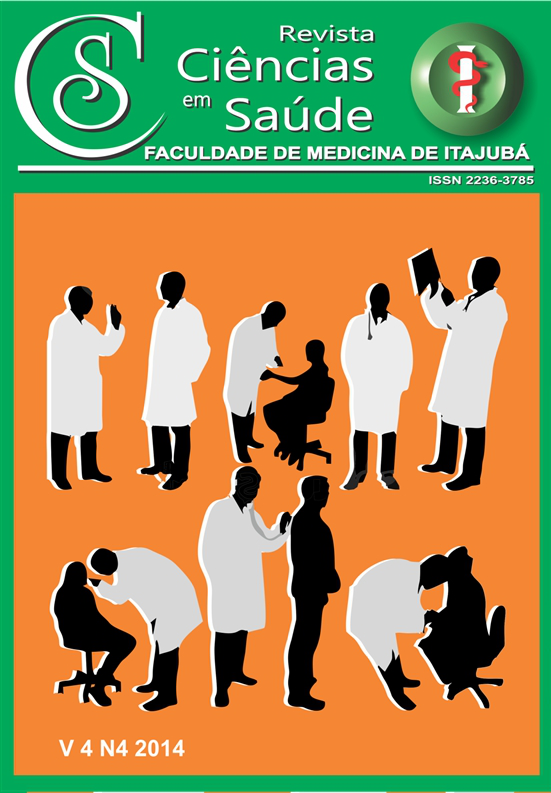Estresse Ocupacional em Profissionais de Saúde: um Estudo com a Equipe de Enfermagem da Unidade de Terapia Intensiva - UTI de um Hospital Escola em Minas Gerais/ Occupational Stress in Health Professionals: A study with the Nursing Team of the Intensive C
Main Article Content
Abstract
Objetivo: identificar no Hospital Escola de Itajubá - HE, o nível de estresse da equipe de enfermagem atuante nas UTIs, no ano de 2014. Materiais e Métodos: Foram aplicados o Inventário de Sintomas de Stress para Adultos de Lipp (ISSL) e um Questionário sociodemográfico, com perguntas sobre idade, procedência, estado civil, escolaridade, entre outros. Após a análise do ISSL e do questionário, foi feita a tabulação da frequência dos sintomas de estresse apresentada pela equipe de enfermagem e uma correlação com as variáveis apresentadas no questionário sociodemográfico. Resultados: Foram observados sintomas de estresse em 50% da amostra, sendo estes mais prevalentes entre a população feminina (92% versus 8%), os solteiros (60% versus 40%), com maior grau de escolaridade (55,55% versus técnico 46,87%), moradores de cidades vizinhas (72,70% versus 43,60%) e da zona rural (85,70% versus 44,20%). Entre as quatro fases do estresse, houve maior predominância na fase de resistência (80%), seguidos da fase de exaustão e quase exaustão. O principal sintoma observado foi o psicológico (64%). Conclusão: De fato observou-se presença de estresse na equipe, com maior predominância na fase de resistência e com maior indicativo de sintomas psicológicos.
Palavras Chave: Enfermagem, UTI, Avaliação, Psicologia.
ABSTRACT
Objective: identify the level of stress in an active nursing team at the ICUs of the School Hospital of Itajubá - HE, during 2014. Materials and Methods: The Inventory of Stress Symptoms of Lipp’s for Adults (ISSL) was used as well as a sociodemographic Questionnaire, containing questions about age, origins, marital status, school level, and others. After analysis of the ISSL and the Questionnaire, resulting in the tabulation of the stress symptom frequency presented in the nursing team and its correlation to the variations presented in the sociodemographic Questionnaire. Results: Stress symptoms were observed in 50% of the sample, being most prevalent in feminine population (92% vs 8%), in the single ones (60% vs 40%), in the ones with higher school level (55,55% vs 46,87%) of technical level, in citizens from surrounding cities (72,70% vs 43,60%) and countryside (85,70% vs 44,20%). Among the four sentences of stress, there was higher predominance in the one about resistance (80%), followed by the one about exhaustion and almost exhaustion. The main symptom observed was the psychological (64%). Conclusion: In fact, the presence of stress in the team was observed, with higher predominance in the phase of resistance and higher indicative of psychological symptoms.
Keywords: Nursing, ICU, Evaluation, Psychology.
Article Details
Authors maintain copyright and grant the HSJ the right to first publication. From 2024, the publications wiil be licensed under Attribution 4.0 International 
 , allowing their sharing, recognizing the authorship and initial publication in this journal.
, allowing their sharing, recognizing the authorship and initial publication in this journal.
Authors are authorized to assume additional contracts separately for the non-exclusive distribution of the version of the work published in this journal (e.g., publishing in an institutional repository or as a book chapter), with acknowledgment of authorship and initial publication in this journal.
Authors are encouraged to publish and distribute their work online (e.g., in institutional repositories or on their personal page) at any point after the editorial process.
Also, the AUTHOR is informed and consents that the HSJ can incorporate his article into existing or future scientific databases and indexers, under the conditions defined by the latter at all times, which will involve, at least, the possibility that the holders of these databases can perform the following actions on the article.

